|
Originally from South Africa, the agapanthus is a flower that entrances many garden visitors. Their tall statuesque structure creates a lasting impression in many gardens, including Plas Cadnant. As you walk through the gates of the walled garden the flowers catch your eye in the distance. Perhaps it is no surprise that many people adore their presence since their name translates from Greek as 'love flower' (agapi = love + anthos = flower). 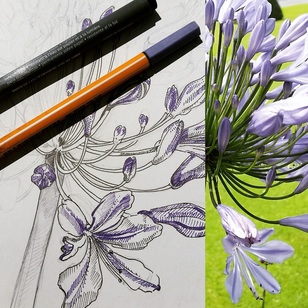 On a bright sunny summer Sunday in July, I was able to sit on the edge of the lawn and draw the large soft violet agapanthus. Like the alliums in the borders across the path. they are a complicated drawing adventure. On the whole they are like a lollipop. Long lean stem that holds a circular gathering of flowers on top. Proudly, each of the flowers point upwards toward the sun, smaller secondary stems support each bloom arching upwards. Bees and other insects are also actively attracted to these flowers. Naturally clever they stand proud in the summer sun. July as a whole has been a busy month of drawing, the colours have changed from whites, pinks and fuschias to blues and yellows as the summer settles in. August promises to be the same if the warmth continues here in North Wales then we are in for another beautiful summer month before the cool autumn weather arrives. This month I am also hoping to complete a few of the ongoing larger pieces of work inspired by the gardens so please keep in touch via this website, twitter or instagram.
0 Comments
" ... the sheen of a peony in bud, not yet opened to the heat of the day but with the dew of the morning upon it still. A peony, cool and close, looking down upon the lush grass from some terraced border, and later, at high noon, the petals unfolding to the sun." - Daphne du Maurier
Peonies are regal flowers originating from China. They are hardy and longlived plants that can individually live to be a hundred years old. At Plas Cadnant this beautiful cerise coloured peony came in to bloom from a darker wine coloured bud in May. It is an ideal representation of a 'feminine' flower that reminds us of all the layers over a crinoline, a blousy bomb.
For me, this peony is vastly complicated in both bud and bloom form. In the bud the petals are tightly packed, pressed and folded to ensure their petals will open in to the delicate waves. The bloom mimics the rounded shape of the bud but dramatically increases in size. By increasing size it dominates the borders but also begins to display a greater sense of fragility, beauty and intricacy.
The detail is a bit obsessive but that is exactly what I like! The complexity of the structures as they are rendered in line is my intention. Overall I am really pleased with this drawing and am hoping to follow it up soon with a finished magnolia drawing and am working on a peony woodblock print.
Further information about purchasing this work can be found here.
as such, the flowers bloom on bare branches with no leaves to camouflage them. In full view the flowers are magnificent.
In the gardens there are different varieties of magnolia. The 'atlas' stands in the valley overlooking the river showing of large blooms; the 'soulangeana' welcomes you from the entrance gates as it is seen at the bottom of the walled garden and the pale pink 'stellata' through the tunnel by the green man fountain. These are not the only magnolias in the garden by they are the three that caught my eye this month. I am reassured that there is one magnolia in the garden that had yet to bloom so will look forward to this in future. In the meantime, I have been observing the tulips and awaiting the peonies.
These morning walks allowed me to capture quick sketches and photographs of the blooms on display. At this time of year the snowdrops are waning and the Hellebore are abundant. A few brave, sun bathed Camellias and Rhododendrons are also flowering.
The valley has a gentle light as the trees are just starting to bud. In a few weeks with a bit more warmth the herbaceous borders will begin to bounce in to action filling in around the Euphorbia. The magnolia tree at the bottom of the walled garden is starting to display its beauty and will likely be my subject of choice next Sunday! This week the Hellebore took pride of place on my drawing board. They are represented by shades of white, pink and purple in the gardens. Nestled in below the trees and at the edges of the paths they acknowledge the entrance of spring and the final days of winter with each nodding bloom. Reading about the flowers reveals a mixed past associated with the flower's poisonous effects, medicinal qualities, their popularity in the 1850s, and the associations with being named to 'Christmas Rose'. The deep purple coloured Hellebore near the 'green man' fountain captured my attention. Their tinged blue leaves, yellow core and central stamens are intriguing. The stamens reach out to tempt the bees but are also sheltered by the sepals (not petals!). This is how the Hellebore maintain their lengthy appearance because the sepals appear like petals, and the petals are concealed between the sepals and the stamen. By capturing a few different views of the flowers I was able to develop my detailed drawing. With the composition resolved my drawing just needs a last burst of energy to complete in advance of next weekend. So hopefully it will be on display for Sunday the 3rd of April. In 1915, a group of artists in Provincetown, Massachusetts, USA, developed a printmaking techniques known as Provincetown, or 'whiteline', woodblock printing. Artists including Blanche Lazzell and Ferol Sibley Warthen were inspired by the Eastern traditions of the Japanese Ukiyo-e woodcut prints but wanted to use one woodblock to print multiple colours rather than a different block for each colour. This printmaking method brought traditional Eastern techniques together with a more modern Western approach. While developing work inspired by the Hidden Gardens at Plas Cadnant I am also going to be expanding my knowledge of printmaking by creating work using the Provincetown technique. The image below illustrates the progress of one of my first prints based an image of the Snowdon Lily.
The subtlety of this technique will nicely complement my other drawing, painting and printmaking work associated with flora.
The trumpet centre speaks to me, as if it is calling out for attention - summoning a smile each morning as it is laced with dew drops.
It is said that asters "came to be when the Greek goddess Asterea cried about the lack of stars on earth. Where her tears fell, asters grew."
The myth of Asterea recounts how she was saddened by the lack of stars on earth and with each tear that dropped to the ground an aster would grow. As we see the nights draw in and the clouds overtake the night skies, it is nice to know that we can still see some stars during the day.
|
AuthorSarah G. Key Archives
July 2016
Categories |

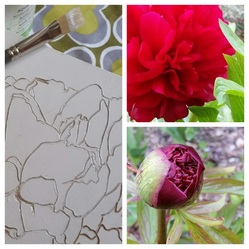
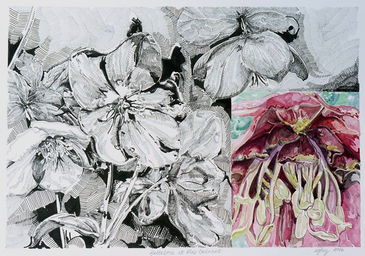
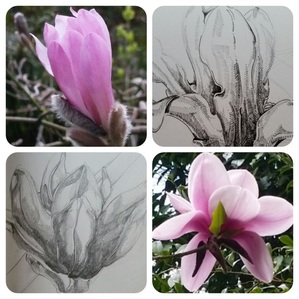
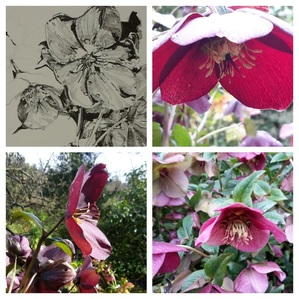
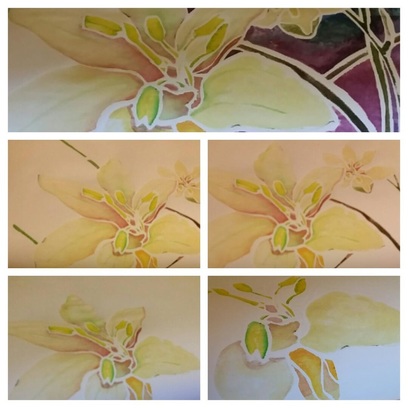
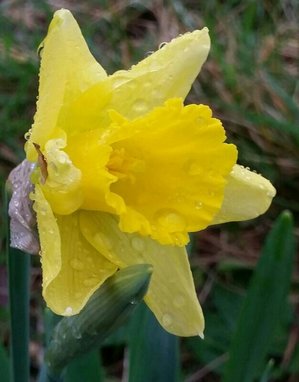
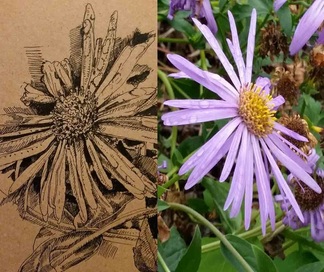
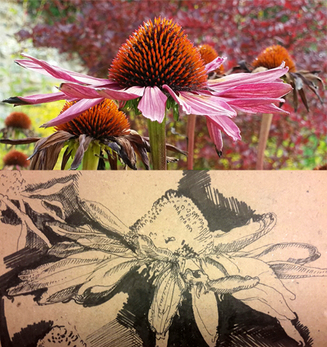
 RSS Feed
RSS Feed
